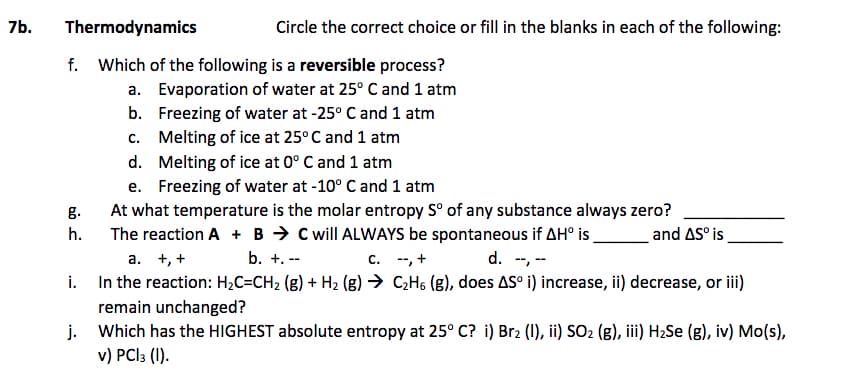b. Thermodynamics Circle the correct choice or fill in the blanks in each of the following: f. Which of the following is a reversible process? a. Evaporation of water at 25° C and 1 atm b. Freezing of water at -25° C and 1 atm c. Melting of ice at 25° C and 1 atm d. Melting of ice at 0° C and 1 atm e. Freezing of water at -10° C and 1 atm At what temperature is the molar entropy S° of any substance always zero? The reaction A + B > Cwill ALWAYS be spontaneous if AH° is a. +, + g. h. and AS° is c. -, + i. In the reaction: H2C=CH2 (g) + H2 (g) → C;Hs (g), does AS° i) increase, ii) decrease, or ii) b. +. -- d. --, -- remain unchanged? j. Which has the HIGHEST absolute entropy at 25° C? i) Br2 (1), ii) SO2 (g), iii) H2Se (g), iv) Mo(s), v) PCI3 (I).
b. Thermodynamics Circle the correct choice or fill in the blanks in each of the following: f. Which of the following is a reversible process? a. Evaporation of water at 25° C and 1 atm b. Freezing of water at -25° C and 1 atm c. Melting of ice at 25° C and 1 atm d. Melting of ice at 0° C and 1 atm e. Freezing of water at -10° C and 1 atm At what temperature is the molar entropy S° of any substance always zero? The reaction A + B > Cwill ALWAYS be spontaneous if AH° is a. +, + g. h. and AS° is c. -, + i. In the reaction: H2C=CH2 (g) + H2 (g) → C;Hs (g), does AS° i) increase, ii) decrease, or ii) b. +. -- d. --, -- remain unchanged? j. Which has the HIGHEST absolute entropy at 25° C? i) Br2 (1), ii) SO2 (g), iii) H2Se (g), iv) Mo(s), v) PCI3 (I).
Chemistry: Principles and Reactions
8th Edition
ISBN:9781305079373
Author:William L. Masterton, Cecile N. Hurley
Publisher:William L. Masterton, Cecile N. Hurley
Chapter16: Spontaneity Of Reaction
Section: Chapter Questions
Problem 89QAP: Consider the following reaction with its thermodynamic data: 2A(g)+B2(g)2AB(g)H0;S0;Gat60C=+10kJ...
Related questions
Question
7 help

Transcribed Image Text:7b.
Thermodynamics
Circle the correct choice or fill in the blanks in each of the following:
f. Which of the following is a reversible process?
a. Evaporation of water at 25° C and 1 atm
b. Freezing of water at -25° C and 1 atm
c. Melting of ice at 25° C and 1 atm
d. Melting of ice at 0° C and 1 atm
e. Freezing of water at -10° C and 1 atm
At what temperature is the molar entropy S° of any substance always zero?
The reaction A + B → C will ALWAYS be spontaneous if AH° is
а. +, +
g.
h.
and AS° is
b. +. --
c. --, +
d. -, --
i. In the reaction: H2C=CH2 (g) + H2 (g) → C;H6 (g), does AS° i) increase, ii) decrease, or iii)
remain unchanged?
j. Which has the HIGHEST absolute entropy at 25° C? i) Br2 (1), ii) SO2 (g), iii) H2Se (g), iv) Mo(s),
v) PCI3 (1).
Expert Solution
This question has been solved!
Explore an expertly crafted, step-by-step solution for a thorough understanding of key concepts.
Step by step
Solved in 2 steps with 1 images

Knowledge Booster
Learn more about
Need a deep-dive on the concept behind this application? Look no further. Learn more about this topic, chemistry and related others by exploring similar questions and additional content below.Recommended textbooks for you

Chemistry: Principles and Reactions
Chemistry
ISBN:
9781305079373
Author:
William L. Masterton, Cecile N. Hurley
Publisher:
Cengage Learning

Chemistry for Engineering Students
Chemistry
ISBN:
9781337398909
Author:
Lawrence S. Brown, Tom Holme
Publisher:
Cengage Learning

Chemistry & Chemical Reactivity
Chemistry
ISBN:
9781337399074
Author:
John C. Kotz, Paul M. Treichel, John Townsend, David Treichel
Publisher:
Cengage Learning

Chemistry: Principles and Reactions
Chemistry
ISBN:
9781305079373
Author:
William L. Masterton, Cecile N. Hurley
Publisher:
Cengage Learning

Chemistry for Engineering Students
Chemistry
ISBN:
9781337398909
Author:
Lawrence S. Brown, Tom Holme
Publisher:
Cengage Learning

Chemistry & Chemical Reactivity
Chemistry
ISBN:
9781337399074
Author:
John C. Kotz, Paul M. Treichel, John Townsend, David Treichel
Publisher:
Cengage Learning

Chemistry & Chemical Reactivity
Chemistry
ISBN:
9781133949640
Author:
John C. Kotz, Paul M. Treichel, John Townsend, David Treichel
Publisher:
Cengage Learning


Chemistry for Today: General, Organic, and Bioche…
Chemistry
ISBN:
9781305960060
Author:
Spencer L. Seager, Michael R. Slabaugh, Maren S. Hansen
Publisher:
Cengage Learning